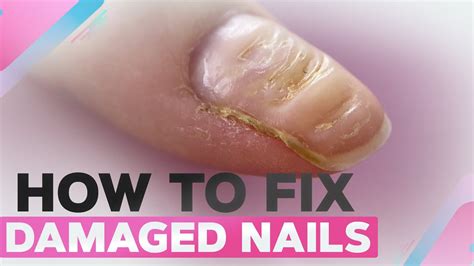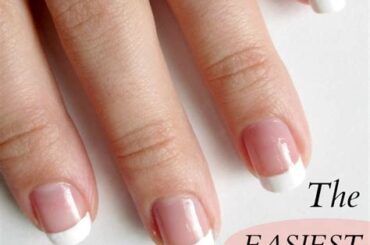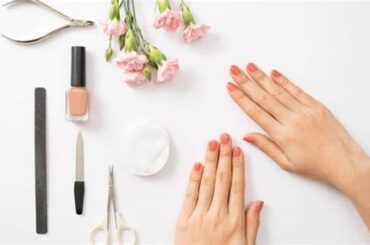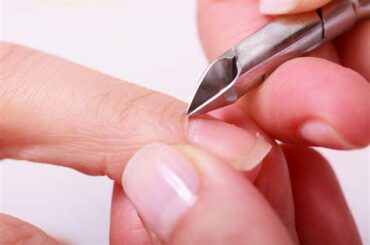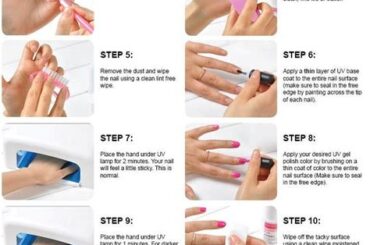Learn how to understand, identify, and care for damaged nails. Discover tips for maintaining nail hygiene, avoiding harmful products, and seeking professional help.
Understanding nail damage
Understanding nail damage
Understanding the various types of nail damage is crucial in maintaining healthy and beautiful nails. Nail damage can occur in many forms, including peeling, splitting, cracking, and brittleness. These issues are often a result of inadequate nail care practices, exposure to harsh chemicals, or poor overall health. It is important to identify the specific type of damage to properly address and prevent further issues.
One of the most common causes of nail damage is excessive exposure to water and harsh chemicals. Constantly exposing the nails to water can soften and weaken them, leading to peeling and breakage. Harsh chemicals, such as those found in cleaning products and nail polish removers, can also strip the nails of their natural oils, causing them to become dry and brittle. Choosing the right nail care products and protecting the nails from these factors are essential in preventing damage.
Maintaining proper nail hygiene is also key in preventing damage. This includes keeping the nails clean and dry, regularly trimming and filing them, and moisturizing the nails and cuticles. Additionally, seeking professional help when needed, such as visiting a nail technician or dermatologist, can provide valuable advice and treatment options to address and prevent nail damage. By understanding the common causes of nail damage and taking the necessary steps to prevent it, you can maintain strong, healthy nails.
Identifying common causes
Nail damage can be caused by a variety of factors, and it’s important to be aware of these common causes in order to prevent it from happening. One common cause of nail damage is excessive exposure to water and harsh chemicals. Whether you’re washing dishes or swimming in a pool, prolonged exposure to water can weaken the nails and make them more prone to breakage. In addition, many household cleaning products and beauty treatments contain harsh chemicals that can strip the nails of their natural oils and weaken them.
Another common cause of nail damage is improper nail care practices. This can include using your nails as tools to open things, biting or picking at the nails, or using the wrong tools for nail care. These habits can lead to nail breakage, peeling, and other forms of damage.
Finally, nutritional deficiencies can also play a role in nail damage. A lack of essential vitamins and minerals, such as biotin, calcium, and iron, can result in brittle and weak nails that are more prone to breaking. Identifying these common causes of nail damage is the first step in preventing it and maintaining healthy, strong nails.
Choosing the right nail care products
Choosing the right nail care products
When it comes to maintaining healthy nails, it’s important to choose the right nail care products. The market is flooded with various options, but not all products are created equal. It’s crucial to do your research and select products that are specifically designed to promote nail health and strength.
Look for nail care products that contain ingredients such as biotin, vitamin E, and keratin, which are known to support nail growth and improve nail strength. Avoid products that contain harsh chemicals such as formaldehyde, toluene, and dibutyl phthalate, as these can cause damage to the nails and surrounding skin.
Additionally, consider the overall health of your nails when choosing products. If your nails are brittle and prone to breakage, opt for strengthening treatments and moisturizing creams. On the other hand, if your nails are prone to discoloration or fungal infections, look for antifungal or brightening products to address these concerns.
Maintaining proper nail hygiene
Proper nail hygiene is essential for overall nail health and appearance. One of the most important aspects of maintaining proper nail hygiene is keeping your nails clean. This involves regular washing of the hands and nails with mild soap and warm water. Cleaning underneath the nails with a nail brush can also help remove dirt and bacteria that may be hiding.
Another key aspect of maintaining proper nail hygiene is keeping the nails trimmed and filed. Regularly trimming your nails can prevent them from breaking and becoming jagged, which can lead to further damage. It’s important to file your nails in one direction to prevent splitting and weakening of the nails.
Moisturizing the nails and cuticles is also crucial for proper nail hygiene. Applying a moisturizing nail cream or cuticle oil can help prevent dryness and cracking, which can lead to nail damage. It’s important to choose products that are specifically designed for nail and cuticle care, as regular hand lotion may not provide the necessary hydration.
Tips for filing and shaping nails
When it comes to maintaining healthy and beautiful nails, proper filing and shaping techniques are essential. One of the most important tips for filing and shaping nails is to use the right tools. It’s important to invest in a good quality nail file and nail clippers to ensure that you’re not damaging your nails in the process. Additionally, it’s crucial to file your nails in one direction only, rather than using a back and forth motion, which can weaken the nails and cause them to split.
Another key tip for filing and shaping nails is to choose the right nail shape for your fingers. Different nail shapes, such as square, oval, or almond, can complement different finger shapes and sizes. It’s important to consider your natural nail shape and finger shape when deciding on the most flattering nail shape for you. Additionally, it’s important to file and shape your nails when they’re dry, as wet nails are more prone to breakage and damage.
Finally, it’s crucial to finish off your filing and shaping routine with a high-quality cuticle oil or nail strengthener. This will help to nourish and protect your nails, keeping them strong and healthy. By following these tips for filing and shaping nails, you can maintain beautiful, strong nails without causing damage or harm to them in the process.
Protecting nails from harsh chemicals
When it comes to protecting our nails from harsh chemicals, it’s important to be mindful of the products we come into contact with on a daily basis. Many everyday household cleaning products, such as bleach and detergents, can be incredibly damaging to our nails. By wearing gloves while cleaning, we can create a barrier between our nails and these harsh chemicals, preventing damage and maintaining the health of our nails.
Additionally, it’s crucial to be cautious of the nail care products we use, as some of them may contain harmful chemicals that can weaken and damage our nails. When choosing nail polish and nail polish removers, look for natural and nourishing options that are free of toxic ingredients. This will help protect your nails from unnecessary exposure to damaging chemicals and keep them strong and healthy in the long run.
Lastly, it’s important to be mindful of our overall environment and the chemicals we come into contact with on a regular basis. Whether it’s in the workplace or at home, taking precautions to minimize exposure to harsh chemicals can go a long way in protecting the health and strength of our nails. By being conscious of the products we use and the environments we inhabit, we can proactively protect our nails from damage and maintain their overall health and appearance.
Avoiding excessive acrylic and gel use
Many people love the look of long, polished nails that acrylic and gel manicures can provide. However, it’s important to be aware of the potential damage that excessive use of these treatments can cause to your nails. Acrylic and gel manicures involve the use of harsh chemicals and prolonged exposure to UV light, which can weaken and damage the natural nail.
It’s essential to give your nails a break in between acrylic or gel manicures to allow them to recover and grow stronger. Constant use of these treatments can lead to thin, brittle nails that are prone to splitting and breakage. If you do choose to get acrylic or gel manicures, make sure to follow up with proper nail care and maintenance to minimize the risk of damage.
Additionally, consider alternative options such as dip powder or regular nail polish to give your nails a break from the harsh chemicals and chemicals found in acrylic and gel treatments. Prioritizing the health of your natural nails will not only help prevent damage, but also result in stronger, healthier nails in the long run.
Importance of moisturizing nails and cuticles
Importance of moisturizing nails and cuticles
Moisturizing your nails and cuticles is a crucial step in maintaining healthy and strong nails. The skin around the nails, known as the cuticles, can easily become dry and cracked if not properly moisturized. Dry cuticles not only look unsightly, but they can also lead to painful hangnails and potentially even nail infections. Keeping your nails and cuticles moisturized is essential for overall nail health and appearance.
Regular moisturizing can also help prevent nail breakage and peeling. Just like the rest of your skin, nails and cuticles need to stay hydrated to remain healthy. Using a nourishing nail and cuticle oil or cream can help to lock in moisture and protect against environmental damage. Look for products containing vitamin E, jojoba oil, or almond oil for maximum hydration and nourishment.
In addition to using nail and cuticle products, it’s important to also drink plenty of water and maintain a balanced diet to support overall nail health. Remember to always be gentle when caring for your nails and cuticles, and avoid harsh chemicals or excessive filing. By incorporating regular moisturizing into your nail care routine, you can help prevent brittleness, dryness, and breakage, and promote strong, healthy nails.
Seeking professional help when needed
Seeking professional help when needed
When it comes to nail care, sometimes professional help is necessary. If you notice any abnormal changes in your nails such as discoloration, thickening, or an unusual shape, it’s important to seek the advice of a dermatologist or a nail specialist. Ignoring these signs could lead to further damage and potential health issues. Professionals can provide accurate diagnoses and recommend appropriate treatments to address the underlying causes of the nail problems.
Furthermore, if you have persistent nail issues despite following proper nail care routines and using high-quality products, consulting a professional can be beneficial. They can offer personalized advice, perform diagnostic tests, and suggest effective solutions based on your specific nail conditions. In some cases, medical conditions such as fungal infections or psoriasis may be the underlying cause of nail damage, and seeking professional help is essential to manage these conditions effectively.
Additionally, professional manicurists and nail technicians can also provide valuable guidance on maintaining healthy nails and preventing damage. Regular visits to a reputable nail salon can help keep your nails in top condition, as professionals can offer services such as gentle nail filing, proper cuticle care, and customized nail treatments. They can also educate you on proper nail hygiene and recommend suitable nail care products for your individual needs.
Frequently Asked Questions
What are the common causes of nail damage?
Common causes of nail damage include excessive use of nail polish, harsh chemicals, frequent hand washing, and trauma or injury to the nails.
How can I prevent nail damage from excessive use of nail polish?
To prevent nail damage from excessive nail polish use, make sure to give your nails regular breaks from polish, use a base coat to protect the nails, and opt for nail polishes with nourishing ingredients.
What are some tips for protecting nails from harsh chemicals?
To protect nails from harsh chemicals, wear gloves when doing household chores, avoid exposing your nails to excessive acetone or other strong solvents, and regularly moisturize your nails and cuticles.
How does frequent hand washing contribute to nail damage?
Frequent hand washing can strip the nails of natural oils and moisture, leading to dry, brittle nails that are more prone to damage and breakage.
Are there specific nutrients or vitamins that can help prevent nail damage?
Yes, biotin, vitamin E, and omega-3 fatty acids are known to promote healthy nail growth and strength. Consider incorporating these nutrients into your diet or taking supplements if necessary.
What are some signs that indicate nail damage?
Signs of nail damage include discoloration, brittleness, peeling, splitting, and the presence of ridges or grooves on the nails.
How can I promote overall nail health and prevent damage?
In addition to the specific tips mentioned, maintaining a balanced diet, staying hydrated, and practicing good nail hygiene by keeping nails clean and properly trimmed can contribute to overall nail health and prevent damage.

